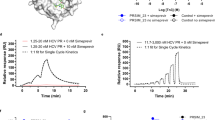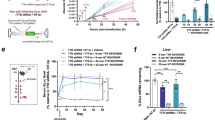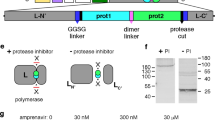Abstract
We developed a method in which the NS3 cis-protease from hepatitis C virus can be used as a ligand-inducible connection to control the function and localization of engineered proteins in mammalian cells. To demonstrate the versatility of this approach, we designed drug-sensitive transcription factors and transmembrane signaling proteins, the activities of which can be tightly and reversibly controlled through the use of clinically tested antiviral protease inhibitors.
This is a preview of subscription content, access via your institution
Access options
Access Nature and 54 other Nature Portfolio journals
Get Nature+, our best-value online-access subscription
$29.99 / 30 days
cancel any time
Subscribe to this journal
Receive 12 print issues and online access
$259.00 per year
only $21.58 per issue
Buy this article
- Purchase on Springer Link
- Instant access to full article PDF
Prices may be subject to local taxes which are calculated during checkout



Similar content being viewed by others
References
Lienert, F., Lohmueller, J. J., Garg, A. & Silver, P. A. Nat. Rev. Mol. Cell Biol. 15, 95–107 (2014).
Gossen, M. & Bujard, H. Proc. Natl Acad. Sci. USA 89, 5547–5551 (1992).
Spencer, D. M., Wandless, T. J., Schreiber, S. L. & Crabtree, G. R. Science 262, 1019–1024 (1993).
Goreshnik, I. & Maly, D. J. J. Am. Chem. Soc. 132, 938–940 (2010).
Davis, K. M., Pattanayak, V., Thompson, D. B., Zuris, J. A. & Liu, D. R. Nat. Chem. Biol. 11, 316–318 (2015).
Rose, J. C. et al. Nat. Methods 14, 891–896 (2017).
Wu, C. Y., Roybal, K. T., Puchner, E. M., Onuffer, J. & Lim, W. A. Science 350, aab4077 (2015).
Bartenschlager, R., Ahlborn-Laake, L., Mous, J. & Jacobsen, H. J. Virol. 67, 3835–3844 (1993).
Lin, M. Z., Glenn, J. S. & Tsien, R. Y. Proc. Natl. Acad. Sci. USA 105, 7744–7749 (2008).
Palida, S. F. et al. J. Neurosci. 35, 7736–7749 (2015).
Chung, H. K. et al. Nat. Chem. Biol. 11, 713–720 (2015).
Pu, J., Chronis, I., Ahn, D. & Dickinson, B. C. J. Am. Chem. Soc. 137, 15996–15999 (2015).
Chavez, A. et al. Nat. Methods 12, 326–328 (2015).
Perez-Pinera, P. et al. Nat. Methods 10, 973–976 (2013).
Gilbert, L. A. et al. Cell 154, 442–451 (2013).
Zalatan, J. G. et al. Cell 160, 339–350 (2015).
Gordon, W. R. et al. Dev. Cell 33, 729–736 (2015).
Morsut, L. et al. Cell 164, 780–791 (2016).
Roybal, K. T. et al. Cell 164, 770–779 (2016).
Varnum-Finney, B. et al. J. Cell Sci. 113, 4313–4318 (2000).
McPhee, F. et al. Antimicrob. Agents Chemother. 56, 5387–5396 (2012).
Lamarre, D. et al. Nature 426, 186–189 (2003).
Seiwert, S. D. et al. Antimicrob. Agents Chemother. 52, 4432–4441 (2008).
Summa, V. et al. Antimicrob. Agents Chemother. 56, 4161–4167 (2012).
Center for Drug Evaluation and Research. Pharmacology/Toxicology NDA Review and Evaluation (Application Number 208,261). U.S. Food & Drug Administration https://www.accessdata.fda.gov/drugsatfda_docs/nda/2016/208261Orig1s000PharmR.pdf (2015).
Sprinzak, D. et al. Nature 465, 86–90 (2010).
Acknowledgements
E.P.T. was supported through a T32 NIH Training Grant awarded to Boston University (EB006359). The pEV-UAS-H2B-Citrine reporter plasmid and CHO-K1 T-REx cells containing stably integrated Gal4- and Notch-dependent reporter constructs were gifts from M. Elowitz (Caltech, Pasadena, CA, USA), the TRE-mTagBFP reporter plasmid was a gift from W. Wong (Boston University, Boston, MA, USA), the 5xGAL4-TATA-luciferase reporter plasmid was a gift from R. Maurer (Oregon Health Sciences University, Portland, OR, USA), and the Tet-inducible mCherry reporter and sgRNA1_Tet-inducible Luciferase plasmids were gifts from M. Sato (University of Tokyo, Tokyo, Japan). BILN-2061 was a gift from R. Tsien and S. Adams (University of California, San Diego, San Diego, CA, USA).
Author information
Authors and Affiliations
Contributions
All of the authors designed and carried out experiments, analyzed data, and contributed to the preparation of the manuscript. Primary responsibility for the development of various constructs was as follows: H.L.D. for the Gal4- and rTetR-based turn-on TFs, E.P.T. for the dCas9-based TFs, S.N.T. for the turn-off TFs, and D.C.S. for the Dll1-NS3 system. J.T.N. supervised the work.
Corresponding author
Ethics declarations
Competing interests
The authors declare no competing interests.
Additional information
Publisher’s note: Springer Nature remains neutral with regard to jurisdictional claims in published maps and institutional affiliations.
Integrated supplementary information
Supplementary Figure 1 Time-dependent analysis of the drug-induced preservation of Gal4-based TFs containing NS3 after treatment of cells with grazoprevir.
Stable cell lines expressing either Gal4DB-NS3-Gal4TA or Gal4DB-NS3-VP64 were treated with 5 μM grazoprevir for the indicated times prior to cell lysis in SDS-PAGE loading buffer and subsequent analysis by western blot. The drug-induced preservation of intact TF copies was determined via the detection of bands corresponding to the intact masses of each TF. Western blots showing the preservation of full-length copies of (a) Gal4DB-NS3-Gal4TA (60.6 kDa), and (b) Gal4DB-NS3-VP64 (57.8 kDa) are displayed. Times refer to the number of minutes over which cells were exposed to drug prior to lysis. Western detection of the TFs was achieved via an HRP-conjugated anti-HA primary antibody, followed by an HRP-conjugated secondary antibody.
Supplementary Figure 2 Activation of a UAS H2B-Citrine reporter gene in cells expressing Gal4DB-NS3-Gal4TA in response to treatment with various NS3 inhibitors.
A Cho-K1 reporter cell line constitutively expressing Gal4DB-NS3-Gal4TA was treated with NS3 inhibitors at varying concentrations and the drug-induced expression of the H2B-Citrine reporter protein was subsequently quantified via flow cytometry. We note that the NS3 sequence used to construct the LInC module contains the T54A mutation, which confers resistance against telaprevir and boceprevir. Geometric means are displayed as mean ± s.d., as determined by three biologically independent samples.
Supplementary Figure 3 Characterization of the rTetR-NS3-VP64-p65 ‘turn-on’ TF.
(a) Schematic depicting the “AND” gate behavior of rTetR-NS3-VP64-p65; the presence of both doxycycline (to induce rTetR binding to tetO sequences) and an NS3 inhibitor (BILN-2061) are required in order to activate transcription from the tetO-containing TRE promoter. (b) Comparison of BFP expression levels in Cho-K1 cells co-transfected with DNA encoding rTetR-NS3-VP64-p65 and a TRE BFP reporter construct. Cells were treated with either doxycycline, BILN-2061, or both drugs at the indicated concentrations for 24 h prior to BFP quantification via flow cytometry. The extent of background activation was assessed through comparison with cells transfected with reporter DNA only. Geometric means are displayed as mean ± s.d., as determined by three biologically independent samples.
Supplementary Figure 4 Reversibility of drug-induced ‘turn-on’ TF preservation.
(a) HEK 293FT cells transfected with DNA encoding rTetR-NS3-VP64-p65 were “pulsed” with drug (5 μM BILN-2061, 24 h) and subsequently “chased” with drug-free media for the indicated times. Following each chase, cells were lysed in SDS PAGE loading buffer and the lysates were subsequently analyzed via western. Intact rTetR-NS3-VP64-p65 (93.3 kDa) and the VP64-p65 cleavage product (42.0 kDa) were detected via fused HA tag. NT refers to a non-transfected control. (b) The reversibility of transcriptional activation by Gal4DB-NS3-VP64 was analyzed using a luciferase-based reporter assay. Applying BILN-2061 and grazoprevir as inducers, a pulse-chase analysis was carried out in which cells were treated with drug, then withdrawn from drug for chase periods of the indicated times. At the end of the time course, the luciferase activity of cells was quantified using a luminescence assay. The data were obtained using Cho-K1 reporter cells (UAS-H2B-Citrine) containing a stably-integrated Gal4DB-NS3-VP64 construct. The cells were transfected with a Gal4-dependent luciferase reporter construct (5xGAL4-TATA-luciferase) and treated with 3 μM BILN-2061 or grazoprevir 16 h later. The first chase was initiated at the 12 h time point after drug addiction. “Last 12” refers to control cells that were transfected and maintained in drug-free media, and treated for only the last 12 h preceding cell lysis. Signal from the “Last 12” samples confirmed that the diminished luciferase activity measured in the chased cells was not due to their decreased drug exposure durations. Luminescence values were normalized to signal from a co-transfected NanoLuciferase control construct (pNL1.1.TK[Nluc/TK]). Values are displayed as mean ± s.d., as determined by three biologically independent samples.
Supplementary Figure 5 Drug-induced gene downregulation via the ‘turn-off’ TFs TMD-NS3-Gal4min and myr-palm-NS3-Gal4min.
Western blotting using an antibody against the Gal4 DB domain was used to confirm the drug-induced preservation of intact versions of (a) TMD-NS3-Gal4min (96.3 kDa) and (b) myr-palm-NS3-Gal4min (62.9 kDa) in cells treated with BILN-2061 (3 μM). In the absence of drug, bands corresponding to cleaved Gal4min (29.2 kDa) domains were observed. DNAs encoding the “turn-off” TFs were transfected into HEK 293FT cells containing a stably integrated Gal4-dependent reporter gene (UAS H2B-Citrine). H2B-Citrine (45.5 kDa) was detected via an anti-histone H2B antibody, and expression of the reporter was observed only in the lysates of drug-untreated treated cells. Lysates from cells containing either the constitutively active Gal4-VP64 TF (23.3 kDa), or a proteolytically inactivated version of TMD-NS3(S139A)-Gal4min were used as controls. (c) The drug-induced downregulation of the UAS H2B-Citrine construct via TMD-NS3-Gal4min or myr-palm-NS3-Gal4min was monitored in transfected HEK 293FT reporter cells treated with grazoprevir at the indicated concentrations via flow cytometry. Geometric means are displayed as mean ± s.d., as determined by three biologically independent samples.
Supplementary Figure 6 Time-dependent western blotting analysis tracking the degradation of cleaved Gal4min domains.
HEK 293FT cells transfected with DNAs encoding either TMD-NS3-Gal4min or TMD-NS3-Gal4min-PEST were grown without inhibitor until treatment with 3 µM grazoprevir at the indicated times prior to lysis in SDS PAGE loading buffer and subsequent analysis by western blot. Detection of the intact and cleaved states of each protein was achieved via labeling with an anti-Gal4 DB antibody on western blots loaded with lysates from cells expressing (a) TMD-NS3-Gal4min, or (b) TMD-NS3-Gal4min-PEST. Bands corresponding to the full-length version of each construct (“Full Construct”) were detected only in lanes loaded with lysates from drug-treated cells. The intensity of the “Full Construct” bands grew over time, indicating accumulation of the intact proteins following NS3 inhibition. Bands corresponding to cleaved Gal4min and Gal4min-PEST were also observed (“Cleaved TF”), the intensities of which diminished over time. The half-life of the Gal4min-PEST was attenuated relative to that of Gal4min. The PEST domain used was derived from the C-terminal region of mouse ornithine decarboxylase (Loetscher, P. et al. (1991) J. Biol. Chem. 266, 15: 11213–11220), which has previously been used to generate a “destabilized” version of GFP with a reduced half-life of 2 h (Li, X. et al. (1998) J. Biol. Chem. 273, 52:34970–34975).
Supplementary Figure 7 Drug-dependent nuclear localization of the dCas9-based ‘turn-on’ TF in cells expressing dCas9-NS3-NLS/VPR.
(a) Transfected HeLa cells were treated with BILN-2061 at the indicated concentrations for 24 h prior to fixation/permeabilization and subsequent staining using anti-Cas9 antibody and DAPI. Scale bar, 25 µm. (b) The extent of nuclear anti-dCas9 signal in cells was determined via a “line” analysis of the pixel intensities along the indicated axes (red) using the ImageJ-based image analysis software FIJI. Anti-dCas9 signals are plotted alongside DAPI intensities.
Supplementary Figure 8 Drug-induced activation of a fluorescent reporter gene using dCas9-NS3-NLS/VPR.
The expression of an H2B-Citrine reporter protein in transfected HEK 293FT containing a plasmidic reporter construct (UAS H2B-Citrine), and DNAs encoding dCas9-NS3-NLS/VPR and a corresponding UAS-binding sgRNA. The drug-induced expression of H2B-Citrine was observed via (a) flow cytometry, and (b) fluorescence microscopy. Cells treated with grazoprevir at the indicated concentrations were analyzed 24 h after drug treatment. For the flow cytometry data, the displayed values are normalized to control cells transfected with the UAS H2B-Citrine reporter and DNA encoding dCas9-NS3-NLS/VPR, but lacking sgRNA. Geometric means are displayed as mean ± s.d., as determined by three biologically independent samples. For the fluorescence microscopy images, green corresponded to emission from the H2B-Citrine reporter protein, and red corresponds to a constitutively expressed mCherry encoded by the sgRNA plasmid. Scale bar, 25 µm.
Supplementary Figure 9 Comparison of drug-induced CXCR4 expression in HEK293FT cells via distinct sgRNA sequences.
sgRNAs targeting the endogenous human promoter of CXCR4 (sgC2 and sgC3, adapted from Zalatan et al. (2015) Cell, 160, 1-2:339–350) were co-transfected into HEK 293FT alongside DNAs encoding either dCas9-VPR, or dCas9-NS3-NLS/VPR. The extent of CXCR4 upregulation was subsequently quantified by flow cytometry using a fluorescently-labeled anti-CXCR4 antibody. Cells containing dCas9-NS3-NLS/VPR were analyzed under drug-treated and untreated conditions (BILN-2061, 3 μM), and compared to catalytically inactive dCas9-NS3-NLS/VPR (NS3 “S139A” mutant), dCas9-VPR containing, and non-transfected HEK 293FT cells (control). Antibody staining of live cells was carried out 24 h following transfection/drug-treatment. Geometric means are displayed as mean ± s.d., as determined by three biologically independent samples.
Supplementary Figure 10 Inducible gene activation using MCP-NS3-VP64.
(a) Schematic of inducible dCas9-mediated transcription via conditional preservation of an sgRNA-binding protein (MCP-NS3-VP64). MCP (MS2 coat protein) binds MS2 hairpin-modified sgRNA and localizes the VP64 TA domain to the DB scaffold in order to mediate gene activation drug-treated cells. (b) Drug-induced activation of a TRE H2B-Citrine reporter protein (yellow) via the co-expression of dCas9, MCP-NS3-VP64, and sgRNA targeting the TRE3G promoter. Positively transfected cells were identified via the detection of a co-transfected fluorescent marker (mTurquoise2, rendered in red). Drug-treated cells were exposed to BILN-2061 (3 μM) for 24 h before imaging. Scale bar, 25 µm.
Supplementary Figure 11 Drug and contact dependence of Notch signaling.
(a) Images of Dll1-NS3 mediated cell-cell signaling captured via epifluorescence microscopy under 10× magnification. Cho K1-derived “sender” cells expressing Dll1-NS3 (Dll1-NS3-mCherry; magenta) were co-cultured in the presence of “receiver” cells expressing human Notch-1 as well as constitutive H2B-Cerulean (cyan) as a fluorescent marker. Notch activation was determined via the expression of an NICD-dependent H2B-Citrine reporter construct in receiver cells (12xCSL H2B-Citrine; yellow). Cells were cultured together in the absence or presence of 1.5 μM BILN-2061 for 72 h prior to imaging. Scale bar, 100 μm. (b) Additional representative images of Dll1-NS3-mCherry mediated cell-cell signaling at 40× magnification. Scale bar, 25 μm. (c) Fluorescence intensities from nuclear H2B-Citrine in individual receiver cells was quantified via analysis of images from untreated and drug-treated co-cultures. Expression of the NICD-dependent reporter was compared between receiver cells that were in direct contact with sender cells, as well as those that were distant from sender cells. Values are displayed as a Tukey-style box plot with mean values (crosses) and n = 110, 103, 206, and 159 individual cells analyzed per group (from left to right). Whiskers extend to the most extreme data point no more than 1.5× the interquartile range (Q3 – Q1) from the box edge, and data points beyond this range are plotted individually.
Supplementary Figure 12 Data regarding the general gating procedures used in flow cytometry analyses.
(a) All live cells were gated using FSC and SSC as represented by the area enclosed within the black line. (b) A positive transfection gate was made by gating for the top 1% fluorescing WT cells. (c) The positive transfection gate was then applied to all transfected cell populations. Geometric mean of reporter fluorescence was then measured from positively transfected cells.
Supplementary information
Supplementary Text and Figures
Supplementary Figures 1–12, Supplementary Table 1
Supplementary Video 1
Comparison of the drug-induced expression of H2B-Citrine in stable cell lines containing either Gal4DB-NS3-Gal4TA or Gal4DB-NS3-VP64. Time-lapse fluorescence imaging of drug-treated (BILN-2061, 2.5 µM) Cho-K1 reporter cell lines (UAS H2B-Citrine) stably expressing either Gal4DB-NS3-Gal4TA, or Gal4DB-NS3-VP64. t=0 refers to time at which cell were exposed to drug (t = hh:mm).
Supplementary Video 2
Reversal of TMD-NS3-Gal4min-mediated gene suppression after drug withdrawal. Time-lapse fluorescence imaging of HEK 293FT reporter cells (UAS H2B-mCherry) transiently transfected with DNA encoding TMD-NS3-Gal4min. Cells were treated with either grazoprevir or danoprevir (3 µM for both) immediately at the time of transfection. Live cell imaging was initiated at 24 h post-transfection (t = 0), at which point cells were either maintained in drug, or released from NS3 inhibition by exchange into drug-free media. Transfected cells that were not exposed to NS3 inhibitors were used as a control. (t = hh:mm).
Supplementary Video 3
Time-lapse imaging of drug-induced mCherry expression via dCas9-NS3-NLS/VPR. Live cell time-lapse imaging of HEK 293FT cells co-transfected with DNA encoding dCas9-NS3-NLS/VPR, an sgRNA sequence targeting the tetracycline operator (tetO), and a reporter construct containing a tetO-regulated mCherry-encoding gene (tetO-mCherry). Imaging was initiated 24 h post-transfection (t=0), at which point cells were either treated with drug (grazoprevir, 3 µM), or imaged in drug-free media as a control (t = hh:mm).
Rights and permissions
About this article
Cite this article
Tague, E.P., Dotson, H.L., Tunney, S.N. et al. Chemogenetic control of gene expression and cell signaling with antiviral drugs. Nat Methods 15, 519–522 (2018). https://doi.org/10.1038/s41592-018-0042-y
Received:
Accepted:
Published:
Issue Date:
DOI: https://doi.org/10.1038/s41592-018-0042-y
This article is cited by
-
Integrated compact regulators of protein activity enable control of signaling pathways and genome-editing in vivo
Cell Discovery (2024)
-
Design of modular autoproteolytic gene switches responsive to anti-coronavirus drug candidates
Nature Communications (2021)
-
Approach for in vivo delivery of CRISPR/Cas system: a recent update and future prospect
Cellular and Molecular Life Sciences (2021)
-
On the cutting edge: protease-based methods for sensing and controlling cell biology
Nature Methods (2020)
-
Multi-input chemical control of protein dimerization for programming graded cellular responses
Nature Biotechnology (2019)



